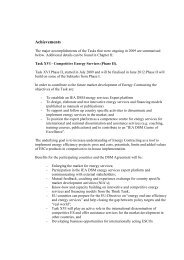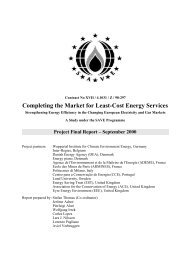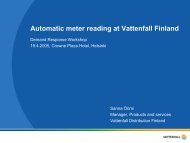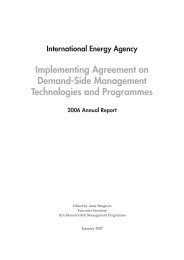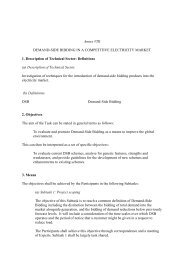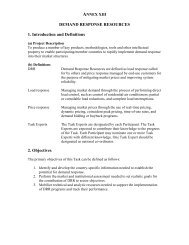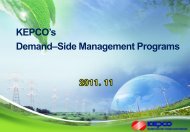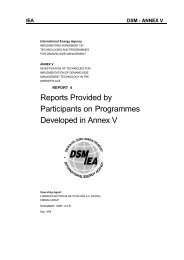Summary and conclusions - IEA Demand Side Management ...
Summary and conclusions - IEA Demand Side Management ...
Summary and conclusions - IEA Demand Side Management ...
Create successful ePaper yourself
Turn your PDF publications into a flip-book with our unique Google optimized e-Paper software.
8 Conclusions8.1 TechnologiesConcerning the emerging end-use technologies it seems to be clear that electric vehicles will playimportant role in the future. Their penetration in different countries will increase in the next 10–20years. Main obstacle is still the price of batteries which still seems to remain in quite a high levelalthough there is potential for decrease during the next 10 years. Role of stakeholders is different indifferent countries as well as proposed business models. The role of some type of aggregator seemsto be important in the future. Smart charging will be essential especially from the local networks’point of view. The services to the electricity system provided by EVs will be additional benefit inthe future. St<strong>and</strong>ardization of the charging connector is on-going. It is not sure if a single connectortype can be established in Europe.Heat pumps represent another emerging end-use technology in many countries. They are used forheating in countries with a cold climate <strong>and</strong> for cooling in countries with hot summers or for bothpurposes. In principle heat pumps are suitable for dem<strong>and</strong> response for several reasons like they canbe controlled similar way as electric heating <strong>and</strong> other air-conditioning systems: due to the natural(building mass) <strong>and</strong> artificial heat storages the heating/hot water production <strong>and</strong> cooling can beswitched off for certain time periods. However, some obstacles exist for the use of heat pumps fordem<strong>and</strong> response like there are not much experiences from the use of heat pumps for dem<strong>and</strong> response <strong>and</strong>therefore also technical solutions have not been developed; after the control period of heat pumps their load will be high <strong>and</strong> this “pay-back” has to betaken into account in the control strategy; starting current of heat pumps after switch-off or blackouts can be high <strong>and</strong> problematic tothe networks; this has to be taken into account; heat pumps should have the technical ability to receive a st<strong>and</strong>ardized signal to charge thethermostat setting.One issue which can be highlighted is the lack of st<strong>and</strong>ardization in the field of Home AreaNetworks (HAN). Often the available market solutions are incompatible. Therefore, the marketneeds full HAN st<strong>and</strong>ardization <strong>and</strong> regulations in order to facilitate the the future provisions ofsmall customer DER solutions [11].µ-CHP technologies generate both heat <strong>and</strong> power <strong>and</strong> can thus be considered in sites where asufficient heat load is present. It has seen as a promising technology to produce electricity locally.DR is easily implemented with µ-CHP because the shut-down <strong>and</strong> start-up costs are relativelysmall, the heating process includes some thermal storage capacity <strong>and</strong> thermal storages arebecoming more commonplace. However, the penetration of µ-CHP is still low <strong>and</strong> much less thanexpected some years ago. The main reason for this is that the prices of the technology have not goneas expected. µ-CCHP units, which combine an absorption chiller, are also available commerciallybut are not affordable without subsidies.PV in customers’ premises is increasing rapidly in some countries. The rapid increase of PVcapacity is related to the two main factors: PV technology <strong>and</strong> manufacturing capacity have been increased rapidly which has resultedin the decrease of PV prices. 35–50 % price reduction can be expected by 2020. Energy policies with incentives <strong>and</strong> feed-in tariffs have supported the PV developmentSmart metering is a technology which is essential in the road to smart grids <strong>and</strong> to the integration ofactive customers to the electrical networks <strong>and</strong> to the market. The penetration is increasing quite26



